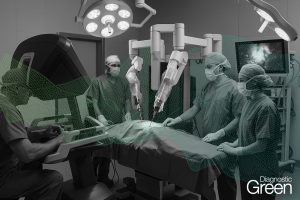Introduction: Anastomotic leakage is one of the most dangerous complications after rectal surgery. It can cause systemic complications, reduce the quality of life and worsen the results of oncological treatment. One of the causes of anastomotic leak is insufficient blood supply to the anastomosis. Intraoperative infrared angiography with indocyanine green (ICG) is expected to improve the assessment of intestinal perfusion and thus prevent anastomotic leakage.
Aim: To present the results of the use of ICG intraoperative angiography during rectal surgery in the prevention of anastomotic leakage.
Material and methods: The study included 76 patients undergoing rectal cancer surgery. Patients were randomized to 2 groups: Group I – 41 patients with ICG intraoperative angiography; and Group II – 35 patients without ICG imaging. Anastomotic leak, length of hospitalization, and complication rate were compared.
Results: Group I patients received intravenous ICG before the anastomosis. Average time of intestinal wall contrasting was 42 s (22-65 s). Average ICG procedure time was 4 min (3.2% of total time of surgery). Three (7.3%) patients after angiography revealed intestinal ischemia requiring widened resection. No anastomotic leak was found post-operatively, and no side effects were observed after administration of ICG. In group II, 3 (8.6%) anastomotic leakages were diagnosed, 2 of which required reoperation.
Conclusions: Intraoperative angiography with ICG in near-infrared light is a safe and effective method of assessing intestinal perfusion. ICG angiography may change the surgical plan and reduce the risk of anastomotic leakage. It is necessary to continue the study until the assumed number of patients is reached.




